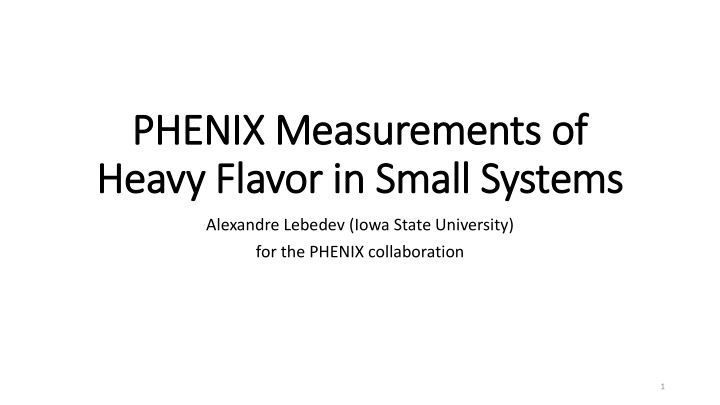



PHENIX Measurements of f Heavy vy Flavor in Small Systems Alexandre Lebedev (Iowa State University) for the PHENIX collaboration 1
Motivation • HF is mainly produced in the initial early stage hard scatterings and ends up a in a variety of final states → sensitive to both initial and final state effects. • While passing through hot and dense nuclear matter HF interacts, but leaves relatively intact → a good tool to study hot and dense matter created in heavy ion collisions • Production in p+p can be calculated in pQCD → calibrated probe. In order to understand what’s happening in HI collisions, we need to fully understand “cold nuclear matter effects” by studying HF in “small” systems. 2
In this talk… • J/ y polarization in p+p collisions @ 510 GeV • J/ y and y (2S) in p/d/He 3 + Al/Au collisions @ 200 GeV • Open charm/bottom via di -electrons in p+p and d+Au @ 200 GeV 3
Silicon vertex detectors The PHENIX detector measure DCA Electrons in Central Arms | h | < 0.35 Df = 2 × p/2 p T > 0.2 GeV/c p/d/He 3 Muons at forward/backward rapidity A 1.2 < | h | < 2.2 Df = 2 p P > 2 GeV/c 4
J/ y polarization in p+p @ 510 GeV Cross-section and p T or rapidity distributions are relatively easy to predict theoretically, many theories do it right. “Polarization” is much more complicated, and allows stringent tests of quarkonia production mechanisms. More appropriate name is spin alignment. Measured via angular distributions of decay products relative to some axis. In the most general case full angular distribution for the decay of spin-1 particle into two spin-1/2 particles can be written as Very often l qf and l f are assumed to be zero. 5
Polarization frames Angles are calculated for positive decay lepton relative to: Helicity (HX) frame: The axis is chosen as the J/ y momentum in the lab frame. - most commonly used frame in collider experiments Collins-Soper (CS) frame: bisector of colliding partons boosted into J/ y rest frame. Gottfried-Jackson (GJ) frame: one of the colliding parton momenta boosted into J/ y rest frame. - used in fixed target experiments 6
Polarization measurement Data Count J/ y after background subtraction in each cos( q ) - f bin. cos( q ) cos( q ) Normalize by simulated acceptance. cos( q ) Fit with 2D polarization function. Simulated acceptance f f 7
J/ y polarization in p+p collisions at 510 GeV Phys. Rev. D 95, 092003 (2017) Calculations in NRQCD factorization approach in Helicity frame describe l q well at high p T , but fail at low p T . No predictions currently for frame-invariant l 8
J/ y and y (2S) in p/d+A : previous PHENIX results At “backward” and mid -rapidity J/ y in d+Au are more suppressed than open HF At mid-rapidity in d+Au y (2S) are more suppressed than J/ y 9
FVTX detector allows for y (2S) measurement at backward/forward rapidity in p+p 10
y (2S) / J/ y in p+p vs. world data arXiv:1609.06550 Once a precursor ccbar is produced, the probability that it will project onto a given charmonium state is insensitive to the conditions which formed the initial ccbar pair. 11
y (2S) in different colliding systems 12
Summary plot The co-mover dissociation model predicts a larger suppression of y (2S) in nucleus-going direction but underestimates the magnitude 13
y (2S) vs. co-mover particle density Relative y (2S) suppression increases as the co-moving particle density increases. Supported by LHC data. 14
Open charm and bottom via di-electrons at mid-rapidity in p+p and d+Au EXODUS: a detailed fast MC package developed within “cocktail” including HF contribution describes data well. PHENIX framework . Models yield of electrons from pseudo-scalar and vector mesons based on measurements. Charm, bottom and Drell-Yan from PYTHIA. 15
Mass and p T distributions of HF After non-HF cocktail subtraction. 16
Charm/bottom separation di-electrons from heavy flavor Use technique described in PRC 91, 2015, 014907: Fit mass and p T distributions simultaneously: charm: low mass, low p T bottom: high mass low p T or low mass high p T Model dependent separation. Three independent calculations based on PYTHIA, MC@NLO and POWHEG 17
Model comparison 18
Charm and bottom cross-sections Extrapolation required to calculate cross-section For charm the decay electron distribution depends on the quark distributions. For bottom this effect is smeared by the decay kinematics (m q >> p T ). No model dependence for R dAu 19
Conclusions • First full measurement of J/ y polarization at RHIC energies represents a challenge to theory and could provide a basis for better understanding of quarkonia production mechanisms. • A wealth of data on J/ y and y (2S) production show enhanced relative suppression of y (2S) in nucleus-going direction. Qualitatively can explained by co-mover dissociation. • Charm and bottom cross -section measurement in p+p and d+Au shows no significant modification in d+Au within experimental uncertainties. 20
Recommend
More recommend